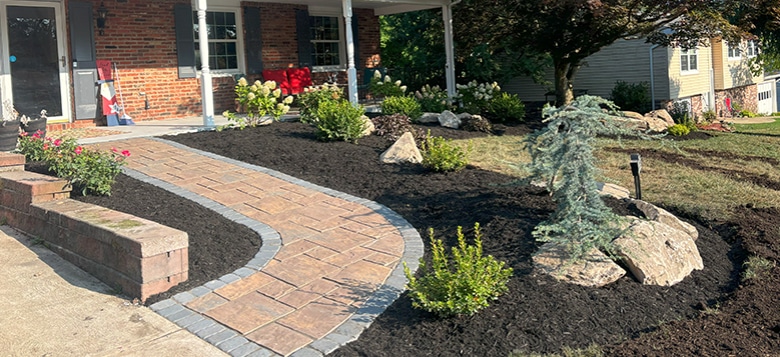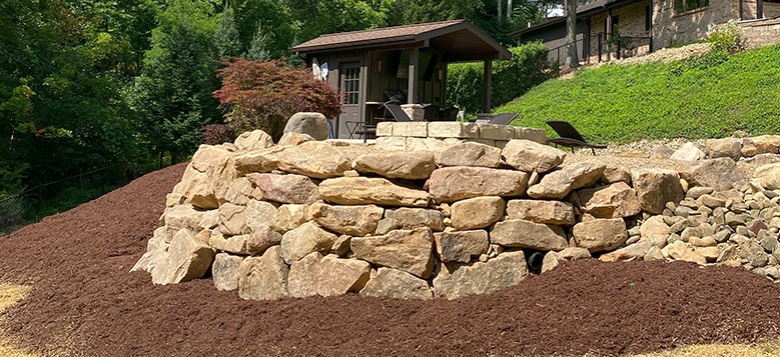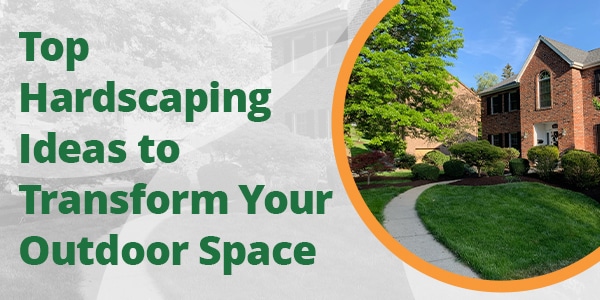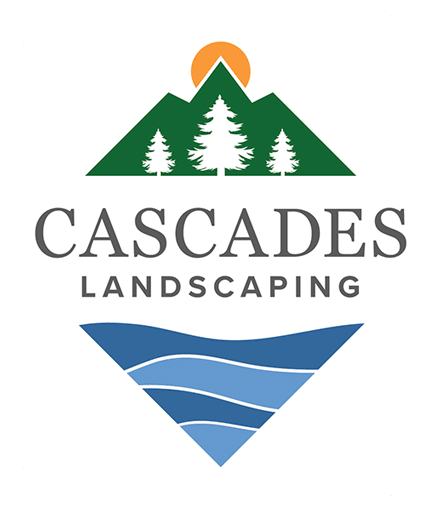Hardscaping uses materials like stone, bricks, wood, and concrete to create durable features in your yard. From patios to walkways, these elements add both function and beauty to outdoor spaces. In this article, discover top hardscaping ideas to transform your yard.
Key Takeaways
- Hardscaping incorporates solid materials like stone, wood, and concrete to create functional and aesthetically pleasing outdoor spaces.
- Key benefits of hardscaping include low maintenance requirements, increased property value, and enhanced usability through defined areas for relaxation and entertainment.
- Essential hardscaping features like patios, walkways, and retaining walls provide structure and organization while creative elements such as fire pits and water features enhance the outdoor experience.
Hardscaping: Definition and Key Elements
Hardscaping involves the incorporation of solid materials in landscaping. This includes the use of stones, wood hardscaping, and concrete. These elements, known as hardscape products, are generally permanent fixtures that exclude plants and vegetation. They provide essential structure and organization to outdoor spaces, creating aesthetically pleasing and functional areas. Typical materials used in hardscaping include stone, wood, and concrete, each bringing its own unique texture and durability to the landscape.
Examples of hardscape elements include patios, driveways, walkways, retaining walls, and outdoor kitchens. These features offer both practical and visual benefits, enhancing the overall appeal and usability of your yard.
Additionally, hardscape elements such as water features and sculptures can add a touch of artistry to your outdoor space. These elements work together to form a cohesive and attractive landscape that complements your home’s architecture and natural surroundings.
Benefits of Hardscaping for Your Yard
Hardscaping offers numerous benefits that go beyond enhancing the visual appeal of your outdoor space. One of the primary advantages is the increased functionality it provides. Hardscaping transforms your yard into a versatile extension of your living space by defining specific areas for relaxation, entertainment, and recreation. Features like patios and decks create designated spots for social gatherings, while walkways improve wayfinding and accessibility throughout the yard.
Another significant benefit of hardscaping is its low maintenance requirements. Unlike traditional landscaping that involves regular upkeep, hardscaped areas require minimal long-term care. This makes them an ideal choice for homeowners looking to reduce the time and effort spent on yard maintenance. Additionally, incorporating retaining walls can help manage water runoff and prevent soil erosion, protecting your property from potential damage.
Hardscaping also adds value to your home. Features such as decks and outdoor kitchens increase your living space and make your property more attractive to potential buyers. Blending indoor and outdoor areas creates a seamless transition, enhancing the overall comfort and usability of your home. Whether you’re aiming to create a peaceful retreat or a lively entertainment area, hardscaping provides the tools to achieve your vision.

Essential Hardscaping Features for Any Backyard
When it comes to transforming your backyard, certain hardscaping features are essential for creating a functional and attractive outdoor space. Retaining walls, patios, decks, and walkways are foundational elements that enhance the organization and usability of your yard.
Each of these features serves a unique purpose, from providing structural support and managing water runoff to creating inviting areas for socializing and relaxation.
Retaining Walls
Retaining walls are crucial for managing water runoff and preventing soil erosion, especially in yards with varying elevations. These structures provide essential support for hills and slopes, reducing the risk of mudslides and property damage. They also allow for the creation of tiered landscapes, which can enhance both the functionality and aesthetic appeal of your retaining wall outdoor space.
One popular project in the Pittsburgh area, involves creating a multifunctional outdoor space with curving retaining walls using top-of-the-line brick products. This project not only adds structural integrity to the yard but also creates visually appealing terraces that maximize the use of available space.
To keep retaining walls in good condition, regularly maintain clear water runoff outlets and check for cracks or weed growth.
Patios and Decks
Patios and decks are perfect for extending your outdoor living spaces, making them ideal for hosting gatherings and enjoying time with family and friends. These areas provide a designated spot for relaxation and entertainment, enhancing the overall outdoor experience. For instance, the owners of a residence in Cranberry sought a hardscaping solution that facilitated large gatherings, resulting in the design of a spacious 70- by 35-foot patio.
In addition to their social benefits, patios and decks significantly improve the aesthetic and functional aspects of your outdoor spaces. Whether you prefer a cozy wooden deck for lounging or a sleek concrete patio for dining, these features can be tailored to suit your style and needs. Incorporating elements like outdoor kitchens and built-in seating can further enhance the usability and appeal of these areas.
Walkways and Pathways
Walkways and pathways play a vital role in guiding foot traffic and enhancing the usability of your outdoor spaces. Strategically placed garden path pathways not only improve accessibility but also add a touch of elegance to your yard. Using natural materials like stone for walkways can create a seamless blend with the surrounding environment, enhancing the overall aesthetic.
Various materials, such as gravel, stepping stones, and pale wood, can be used to create unique and attractive pathways. For example, an L-shaped side walkway lined with paving stones and low retaining walls can provide both practical and aesthetic benefits. Incorporating perennial or annual plants along gravel pathways can further enhance their visual appeal, creating a harmonious and inviting outdoor space.

Creative Hardscaping Ideas to Enhance Your Outdoor Space
To truly elevate your outdoor space, consider integrating creative hardscaping ideas that go beyond the basics. Elements like fire pits, water features, and pergolas can transform your yard into a stunning and functional retreat. For instance, a well-designed fire pit not only provides warmth but also serves as a central gathering spot, making your outdoor space more inviting.
Adding water features, such as fountains and ponds, can create a calming atmosphere and enhance the overall aesthetic of your outdoor spaces. Pergolas and gazebos offer both shade and structure, creating comfortable areas for lounging and entertaining.
By combining these creative elements, you can achieve a harmonious and visually appealing hardscape design that reflects your personal style and enhances your outdoor living experience.
Fire Pits and Outdoor Fireplaces
Fire pits and outdoor fireplaces are fantastic additions to any outdoor space, providing both warmth and ambiance. These features serve as focal points, creating inviting areas for family and friends to gather. Whether you prefer a simple fire pit or a more elaborate outdoor fireplace, these elements can extend the usability of your outdoor spaces well into the cooler months.
Incorporating a fire pit into your hardscape design creates a central gathering spot, enhancing the overall outdoor experience. Imagine cozy evenings spent around the fire, roasting marshmallows and enjoying the company of loved ones. This simple yet impactful addition can transform your yard into a welcoming retreat.
Water Features
Water features, such as fountains and ponds, add a touch of tranquility and elegance to outdoor spaces. These elements not only enhance the visual appeal of your yard but also create a soothing atmosphere that promotes relaxation. The gentle sound of flowing water can provide a sense of calm, making your outdoor space a peaceful retreat.
To ensure the longevity of your water features, regular maintenance is essential. Testing pumps and electrical connections regularly helps keep these features in proper working order.
Incorporating water features into your hardscape design creates a harmonious and inviting outdoor environment, enhancing both aesthetics and functionality.
Pergolas and Gazebos
Pergolas and gazebos are excellent additions to any hardscape design, offering both aesthetic and functional benefits. These structures provide partial shade, making outdoor spaces more comfortable and enjoyable year-round. Additionally, pergolas and gazebos add vertical structure to the landscape, enhancing the overall visual appeal.
Combining a pergola with other hardscape elements, such as patios and walkways, can create a cohesive and inviting outdoor space. These structures serve as focal points in landscaping, providing areas for lounging, dining, or even outdoor cooking. By incorporating pergolas and gazebos into your hardscape design, you can elevate the beauty and usability of your yard.
Sustainable Hardscaping Practices
Sustainable hardscaping practices are becoming increasingly important in the hardscaping industry. Effective hardscaping can manage water drainage and absorption, preventing issues like flooding and soil erosion. Using permeable materials, such as permeable pavers, improves water management and promotes groundwater recharge.
Using sustainable materials, such as reclaimed wood and recycled concrete, reduces environmental impact and promotes eco-friendliness. Additionally, incorporating native plants and drought-resistant landscaping can further enhance the sustainability of your hardscape design.
These practices not only benefit the environment but also create beautiful and resilient outdoor spaces.
DIY vs Professional Hardscaping Projects
Deciding between DIY and professional hardscaping projects depends on various factors, including budget, time, and complexity. DIY hardscaping can provide significant cost savings, allowing homeowners to manage expenses more effectively. However, DIY projects may also lead to mistakes that can be costly to fix, particularly in design and plant selection.
Hiring a professional can save time and ensure a more cohesive and aesthetically pleasing landscape design. Professionals use advanced technology, like 3D rendering, to create detailed visualizations, helping you envision the final result. For complex installations requiring specialized skills or regulatory compliance, hiring a professional is often the best choice.
Maintenance Tips for Long-Lasting Hardscapes
Maintaining your hardscape elements is essential for ensuring their longevity and functionality. Regularly sweeping surfaces helps keep them free from dirt and debris, preventing buildup and potential damage. Addressing stains and spills immediately can prevent them from setting into the surface and becoming permanent.
Checking patios and walkways for cracks and erosion is also crucial. Replenishing sand in joints and repairing any concrete pavers damage as needed can help maintain the structural integrity of your hardscape.
Proper drainage and edging are vital for preventing water-related issues and ensuring the stability of your hardscape project.
How to Plan Your Hardscape Project
Planning your hardscape project begins with clarifying your needs and intended activities. Consider how you want to use your outdoor space and what features are most important to you. Establishing a budget is also crucial, as it helps you understand the costs of materials and installation.
Working with a designer can help you prioritize essential elements and ensure compatibility with future landscaping additions. When choosing a hardscape company, check their experience, customer references, and the presence of a designer on staff.
Proper planning and professional guidance can make your hardscape project a success.
Conclusion
Hardscaping is a powerful tool for enhancing outdoor living spaces. By defining areas for relaxation, recreation, and social gatherings, hardscaping transforms ordinary yards into extraordinary retreats. Essential features like retaining walls, patios, and walkways provide structure and functionality, while creative elements like fire pits and water features add beauty and charm.
Sustainable hardscaping practices and regular maintenance ensure the longevity and eco-friendliness of your outdoor spaces. Whether you choose to DIY or hire a professional, planning your hardscape project carefully will help you achieve your vision. Start transforming your yard today and enjoy the benefits of a well-designed hardscape.
Want to discuss your vision for a hardscape project to transform your outdoor space? Contact Cascades Landscaping to figure out the next steps.
Frequently Asked Questions
What is hardscaping?
Hardscaping refers to incorporating hard surfaces such as stone, wood, and concrete into landscaping, featuring elements like patios, driveways, and retaining walls to improve outdoor spaces. This approach enhances both functionality and aesthetics in your landscape design.
What are the benefits of hardscaping?
Hardscaping significantly enhances both the functionality and aesthetics of your yard, offering low-maintenance, durable solutions that boost property value and effectively manage water runoff and soil erosion. Investing in hardscaping can transform your outdoor space into a well-defined area for relaxation and recreation.
How do I maintain my hardscape elements?
To maintain your hardscape elements effectively, regularly sweep surfaces to prevent dirt buildup, address stains promptly, and check for cracks and erosion. This proactive approach ensures the longevity and functionality of your hardscaping.
What are some creative hardscaping ideas?
Incorporating fire pits, water features, and pergolas into your outdoor spaces can significantly enhance their beauty and functionality. These creative hardscaping elements create inviting areas for socializing and relaxation.

